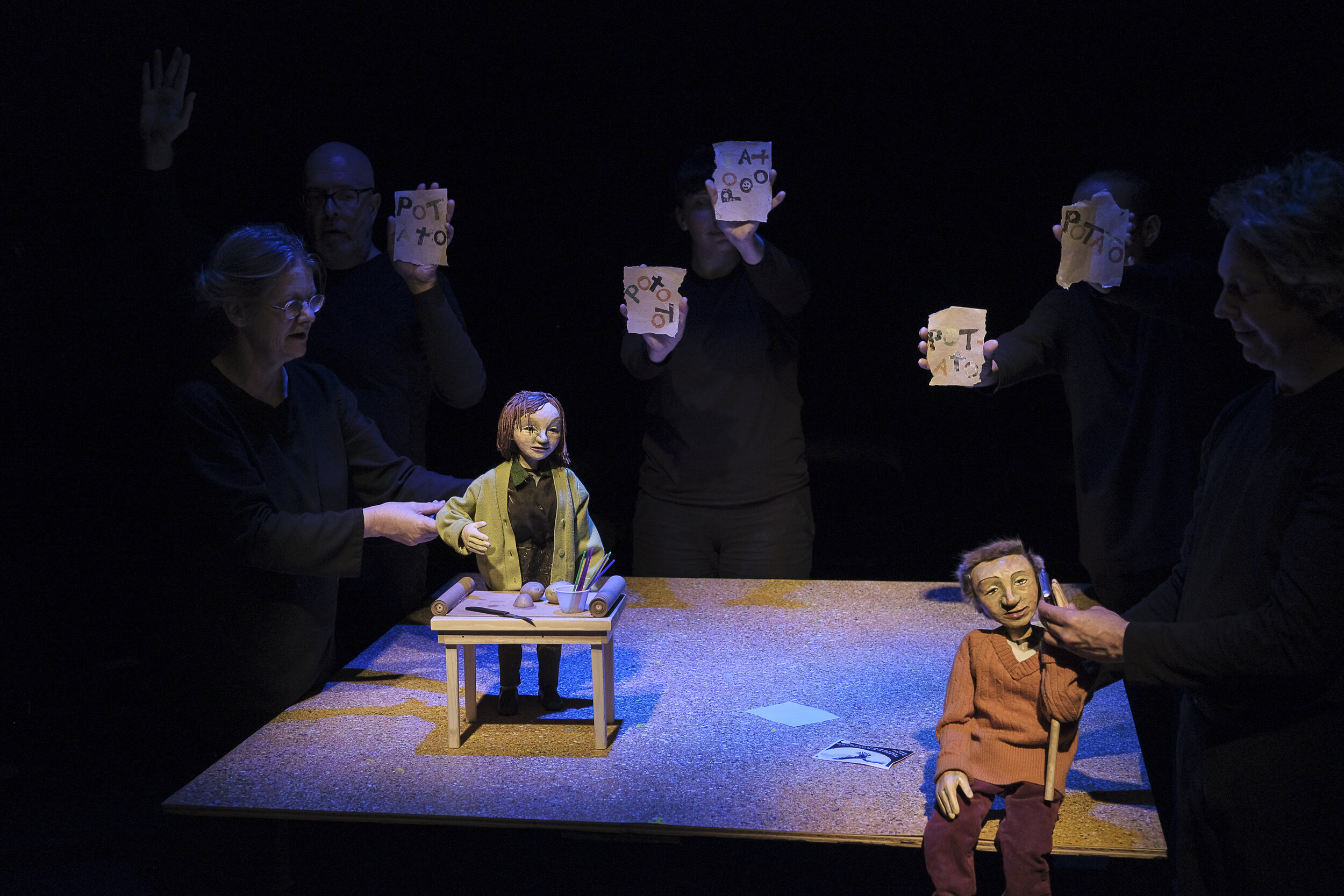


21 Ways To Make The World Last Longer
A black-capped chickadee warns us that our world is in trouble. The story unfolds through 21 (or more!) narratives with characters that in some small way are already contributing to the preservation of the planet’s ecology.
One has started to study birds and their songs, another is teaching his old mother how to ride the bus. Another describes how she has been able to use the same money purse for most of her life. And, the chickadee, in chickadee language, advises throughout.
Poster layout by: Rosa Saba. Photo credit: Cathy Stubington.
A play for 28 rod puppets performed by five puppeteers on a tabletop setting, which transforms with lighting as we move from place to place.
Written by: Cathy Stubington and James Fagan Tait
Directed by: James Fagan Tait
Puppet design: Cathy Stubington
Lighting: Simon Farrow
Puppeteers: Zompopo Flores,Thomas Conlin Jones, Sarah Redmond, Cathy Stubington, James Fagan Tait
21 Ways to Make the World Last Longer was presented in March 2016 at the Belfry Theatre in Victoria and in Salmon Arm, BC, and in November/December 2017 in Revelstoke, Vernon and Saltspring Island, BC, and in Dawson City and at the Yukon Arts Centre in Whitehorse Yukon.
Program is below - click to zoom in
Creation Process
This project grew out of a long-term creative partnership and friendship between James Fagan Tait and Cathy Stubington, and their ongoing conversations and questions about the effects of greed in our society. Initially, it was an exploration of the origins of money, which turned into a massive composite script called Gold, with historical anecdotes, folktales, and true tales, all of which looked at gold from a different angle. This was an informational foundation that 21 Ways to Make the World Last Longer was built from.
Content
Each of the puppet characters has something to share, that he/she/ they have been thinking about or doing. Each of them is something that we believe contributes to making life on earth last longer.
Sally has been learning about birds by making a poster a week and sharing what she is learning by posting them. Peter makes a point of phoning his elderly mother whose thing is to make pies for various people in her life. Laura (who also runs a choir out of her living room) reminisces about her childhood realizations about plastic bags, and how she could be duped by advertising. Miguel loves to walk and appreciates learning the names of flower from his friend. Zack, from the city, wants to learn how to grow his own food from a farmer, and is becoming aware of the importance of bees and the importance of flowers for the bees. (Some of these vignettes come directly from Runaway Moon’s Calendario project escapades.)
Throughout the unfolding and our getting to know those who populate our puppet world, a chickadee flies in and out, and Sally shares what she has been learning about the other birds and animals paying attention to the chickadee’s danger call - which is a call for all of us to listen and attend to.
Style
The entire play unfolds upon a 5 foot square table top with rod puppets manipulated in full view by five performers, dressed in black; a tabletop surface (painted by Molly March) becomes the setting for each story, changing before the audience’s eyes with the help of Simon Farrow’s lighting. It has a simplicity and spaciousness that is beautiful.
The puppeteers blend into the background and manipulate the puppets in a fluid collaboration, but their hands and faces gently emerge from the darkness into the light. Our intent is that the manipulators’ focus actually deflects audiences’ attention to the puppets.
The stories unfold as monologues, but in these monologues, birds appear, memories interrupt, and whole environments change before the audience’s eyes with a spaciousness that is simply beautiful.
The characters are portrayed by more-or-less naturalistic puppets, in contemporary clothing. none of them is a primary character and they are all protagonists. They are in a sense “ordinary people” (and each extraordinary, as we all are), and perhaps can be identified with. Rick Holloway put exquisite care with the detailed soft sculpture of each puppet so that their movement is fluid and convincing.
We are using a model of rod puppet which Cathy and Zompopo learned from Vermont puppeteer Eric Bass, and which James Tait used in a performance directed by him, when we produced “The Caucasian Chalk Circle” at the Caravan Farm Theatre in 1996.
Impact
There is magic in this show. The play is simple with small themes, and the characters themselves are small; there is a recognition of the power of humility and simplicity. Audiences were mesmerized, and fooled, by the technique; some said they felt the lips of puppets were moving. Many commented that they appreciated the focus and stillness of the manipulators surrounding the puppets; they enjoyed watching the supportiveness and tenderness of the positioning of the group of actors. Many audience members identified with the characters in the play and said they felt affirmed in that while the situation of climate change can seem hopeless, whatever small action each person is doing is contributing to the reversal.




























